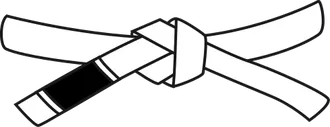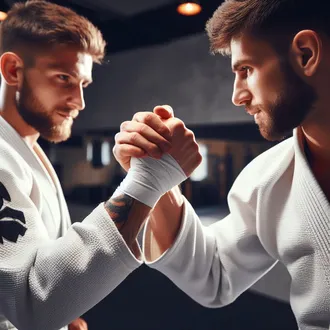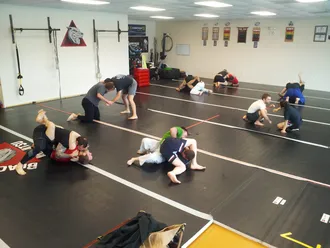
I’m a white belt that never gave up. And that’s the mentality I want my students to get. The belt is the least thing you have to worry (about).
- BJJ Belt Progression Timeline
- White Belt
- Blue Belt
- Purple Belt
- Brown Belt
- Black Belt
- Coral Belt (Red and Black)
- Coral Belt (Red and White)
- Red Belt
- Frequently Asked Questions (FAQ)
- How do BJJ belt promotions work?
- How long does it take to get a white belt in BJJ?
- How long does it take to get a purple belt in BJJ?
- How dangerous is a BJJ blue belt? Are BJJ blue belts good?
- Can you skip belts in BJJ?
- Can you get a BJJ black belt in 5 years?
- What percentage of BJJ white belts quit?
- What is a coral belt in BJJ?
- How many BJJ red belts are there?
- What is the highest BJJ belt?
Brazilian Jiu-Jitsu (BJJ) is more than just a martial art—it’s a lifelong journey of self-improvement, discipline, and skill mastery.
At the core of this journey lies Brazilian Jiu-Jitsu itself, a grappling-based martial art that uses technique, leverage, and strategy to control opponents.
Progress in BJJ is marked by a structured ranking system known as the BJJ belt system, which reflects your progress, experience, and technical expertise.
The five primary BJJ belts are: White, Blue, Purple, Brown, and Black. Each level represents a milestone in skill development, requiring dedication and time on the mats.
Before reaching black belt, practitioners earn up to four stripes per belt, marking progress along the way.
After achieving black belt, the journey continues with degree rankings (1st to 6th-degree black belt), followed by the prestigious coral belts and ultimately the red belt—BJJ’s highest honor.
So, how long does it take to progress through each BJJ belt? Let’s break down the belt system, what each level means, and how long you can expect to spend at each rank.
BJJ Belt Progression Timeline
| 🥋 Belt | ⏳ Time at Rank (Avg.) | 🎯 Key Focus Areas |
|---|---|---|
| ⚪ White Belt | 1-3 years | 🛡️ Survival, basic positions, escapes, learning fundamental movements. |
| 🔵 Blue Belt | 2-3 years | 🔄 Expanding techniques, submissions, positional control, defense improvement. |
| 🟣 Purple Belt | 1.5-3 years | 🧩 Refining game, chaining attacks, counters, deeper strategic thinking. |
| 🟤 Brown Belt | 1-2 years | 📚 Polishing techniques, teaching others, preparing for black belt level. |
| ⚫ Black Belt | 10+ years in total | 🥋 Mastery, strategy, leadership, developing own teaching style. |
| 🔴⚫ Coral Belt (Red and Black) - 7th Degree | 31+ years in BJJ | 🏆 Recognition for technical excellence & significant contribution to BJJ. |
| 🔴⚪ Coral Belt (Red and White) - 8th Degree | ~7 years after Red/Black Coral Belt | 🎖️ Senior level mastery, teaching, and guiding the next generation. |
| 🔴 Red Belt - 9th Degree | ~10 years after Red/White Coral Belt | 🌟 Reserved for lifelong contributors to BJJ who have shaped the art. |
| 🔴 Red Belt - 10th Degree | Final rank - Reserved for founders | 🏅 The highest possible rank in BJJ, held only by the pioneers of the sport. |
⚪ White Belt – Embrace the Basics

The White Belt is the official starting point of your BJJ journey. At this stage, you’re learning the fundamental movements, escapes, and basic submissions while adapting to the unique pace and intensity of live training.
Challenges: Learning to stay calm, absorbing new techniques, and getting comfortable with live resistance.
Time to Blue Belt: 1 to 3 years
Embrace the learning curve—every session on the mat is a step forward in your journey.
🔵 Blue Belt – Building on the Basics

The Blue Belt represents an essential shift in your development. At this level, you move from simply surviving to actively attacking and defending in rolling sessions.
Key Goals:
- Developing a personal game plan
- Improving positional awareness
- Understanding counters and escapes
Estimated Time: 2 to 3 years
Blue belts should focus on sharpening their foundational skills and broadening their knowledge of submissions and defenses.
🟣 Purple Belt – Refining Your Game

By the time you reach Purple Belt, you’re expected to have a deep understanding of BJJ mechanics and strategy. This is the belt where most practitioners start to develop a unique style and preferred techniques.
Focus Areas:
- Chaining techniques together
- Strategic rolling (thinking several steps ahead)
- Refining submission setups
Estimated Time: 1.5 to 3 years
It's often said that if you reach purple belt, you're highly likely to reach black belt.
🟤 Brown Belt – Approaching Mastery

The Brown Belt is considered the final stage before achieving the coveted black belt. At this level, technical precision and leadership become key aspects of your growth.
Refinement Focus:
- Perfecting techniques with precision
- Helping lower belts progress
- Preparing mentally for black belt responsibility
Estimated Time: 1 to 2 years
Brown belts often mentor lower ranks, reinforcing their own skills while preparing for the next stage.
⚫ Black Belt – A New Beginning

Earning a Black Belt in BJJ is a remarkable achievement, marking both mastery and a new stage of learning. At this level, you transition from student to leader, often teaching and refining techniques for the next generation.
Key Aspects:
- Deep technical knowledge
- Efficient movement and energy use
- Passing down knowledge through teaching
Estimated Time to Achieve: 8 to 12+ years
The journey doesn’t end at black belt—it’s just the beginning of a lifelong refinement of skill.
Coral Belt (Red and Black)

Beyond the black belt lies the prestigious coral belt, awarded to those who have dedicated decades to the art of Brazilian Jiu-Jitsu. It comes in two variations: red and black (7th-degree) and red and white (8th-degree), both signifying an advanced level of mastery and contribution to the sport.
Receiving a coral belt is not just about technical proficiency—it is an acknowledgment of a practitioner's impact on BJJ through teaching, competition, and innovation. Very few ever reach this level, making it a true mark of distinction in the martial arts world.
Progression through the black belt degrees requires 3–7 years per degree, meaning that earning a red-and-black coral belt typically takes 31 years of total BJJ practice. This means that reaching the coral belt level may take at least 20 years after first receiving a black belt.
Coral Belt (Red and White)

The next step after the red-and-black coral belt is the red-and-white coral belt, representing the 8th degree of black belt. Typically, it takes around 7 years at the red-and-black level before moving up to red-and-white.
Beyond skill and longevity, achieving coral belt status signifies leadership and significant contributions to the BJJ community. Many coral belt holders are renowned instructors, mentors, or figures who have shaped the sport globally.
Red Belt

The red belt is the highest rank in Brazilian Jiu-Jitsu, reserved for true pioneers of the sport. Often referred to as the Grandmaster rank, this belt is an honor given to those who have spent a lifetime refining and spreading BJJ.
Unlike other belts, red belts are not awarded based on competition performance but rather for their influence, teaching, and historical impact on BJJ. Those who earn this rank are often regarded as living legends of the sport.
Most BJJ federations require practitioners to be at least 50–60 years old with over 45 years of black belt experience before they are eligible for a red belt.
Frequently Asked Questions (FAQ)
How do BJJ belt promotions work?
In Brazilian Jiu-Jitsu, belt promotions are based on a combination of skill proficiency, mat time, competition experience, and instructor evaluation. Some schools follow structured grading systems, while others use a more subjective approach. Stripes on belts often indicate progress before a full belt promotion.
How long does it take to get a white belt in BJJ?
You start as a white belt on your first day of training. There is no minimum time requirement for this rank.
How long does it take to get a purple belt in BJJ?
On average, it takes around 4 to 6 years to earn a purple belt, depending on training frequency and dedication. The typical timeline is 2–3 years at blue belt before progressing to purple.
How dangerous is a BJJ blue belt? Are BJJ blue belts good?
A BJJ blue belt is considered proficient in basic techniques, escapes, and submissions. While they are skilled compared to beginners, they are still developing control and strategy against higher ranks. Their danger level in sparring comes from their growing understanding of techniques but lack of high-level precision.
Can you skip belts in BJJ?
Generally, no. The BJJ belt system follows a strict progression. However, in rare cases, an exceptionally skilled practitioner (such as a high-level wrestler or Judo black belt) might be promoted faster to blue, but should still follow the standard belt sequence.
Can you get a BJJ black belt in 5 years?
While uncommon, it is possible. Elite athletes who train multiple times per day, compete at high levels, and receive dedicated coaching may achieve a black belt in 5–6 years. However, for most practitioners, it takes 8 to 12+ years.
What percentage of BJJ white belts quit?
It’s estimated that around 50% to 70% of BJJ white belts quit before reaching blue belt. The steep learning curve, frustration with progress, and injuries are common reasons for dropouts.
What is a coral belt in BJJ?
A coral belt is awarded at the 7th (red-and-black) and 8th (red-and-white) degrees of black belt. It signifies decades of dedication and contributions to BJJ. Practitioners typically achieve this rank after 30+ years of training.
How many BJJ red belts are there?
The red belt (9th and 10th degree) is the highest rank in BJJ and is extremely rare. Fewer than 30 individuals in history have achieved the 9th-degree red belt, and the 10th-degree red belt is exclusively reserved for BJJ founders.
What is the highest BJJ belt?
The highest belt in Brazilian Jiu-Jitsu is the 10th-degree red belt. It is reserved for the founders of BJJ, such as Carlos and Helio Gracie.
The journey from black belt to 9th-degree red belt spans over 48+ years, and earning a 10th-degree red belt is even rarer—only reserved for the founders of Brazilian Jiu-Jitsu.
Keep Training and Enjoy the Journey!
The BJJ belt system is more than just a ranking structure—it reflects your technical progression, personal growth, discipline, and dedication to the art of Brazilian Jiu-Jitsu.
However, belts are not the goal; they are merely milestones. The true value of BJJ lies in the journey, the lessons learned, and the character you build along the way.
Every practitioner's path is unique—some may progress quickly, while others take longer. Instead of comparing yourself to others, focus on your own improvement, consistency, and love for the art.
So keep training, embrace each challenge, and most importantly, never stop learning!









